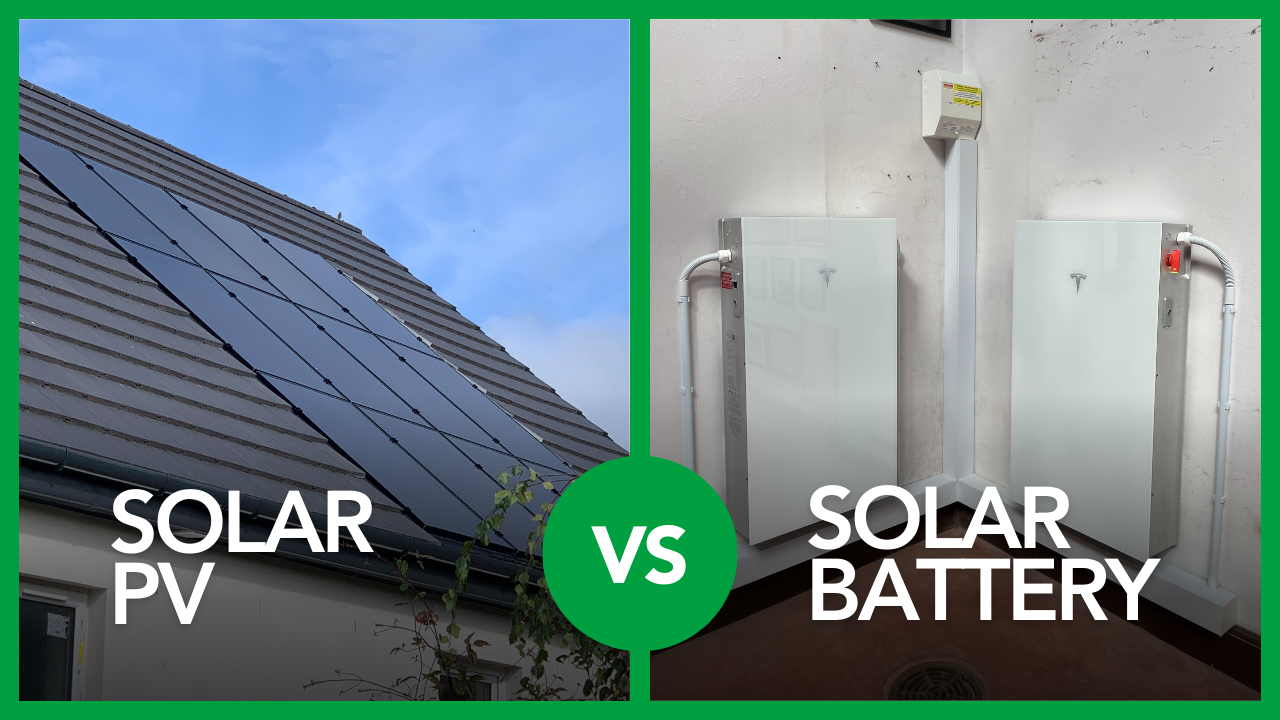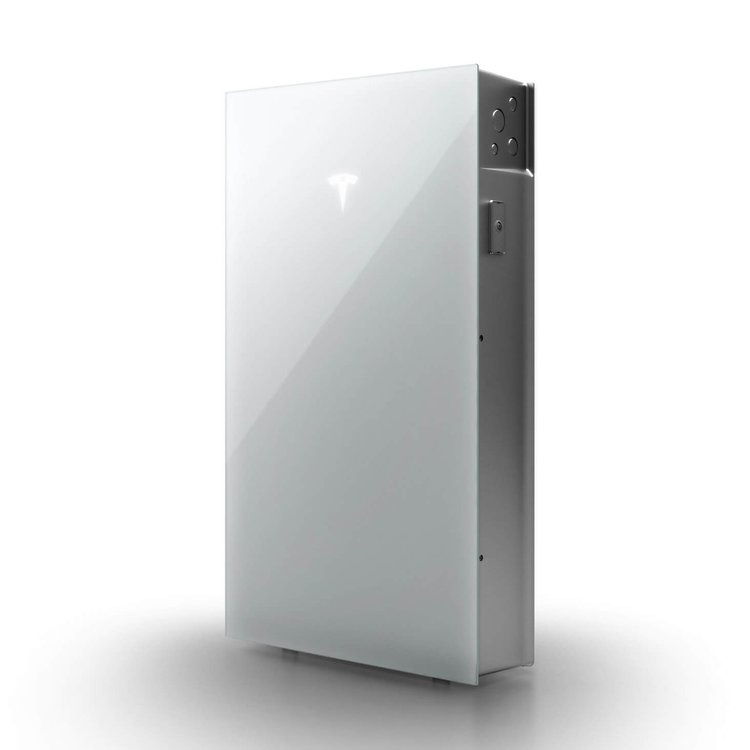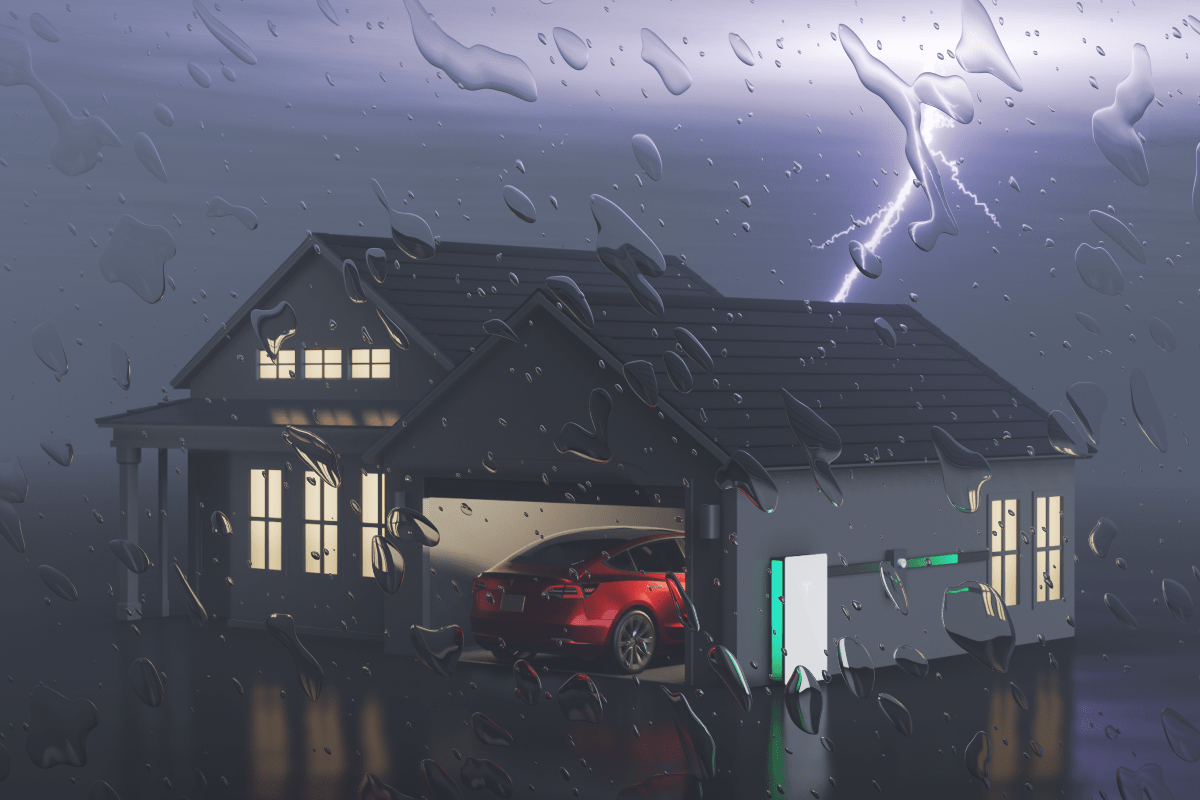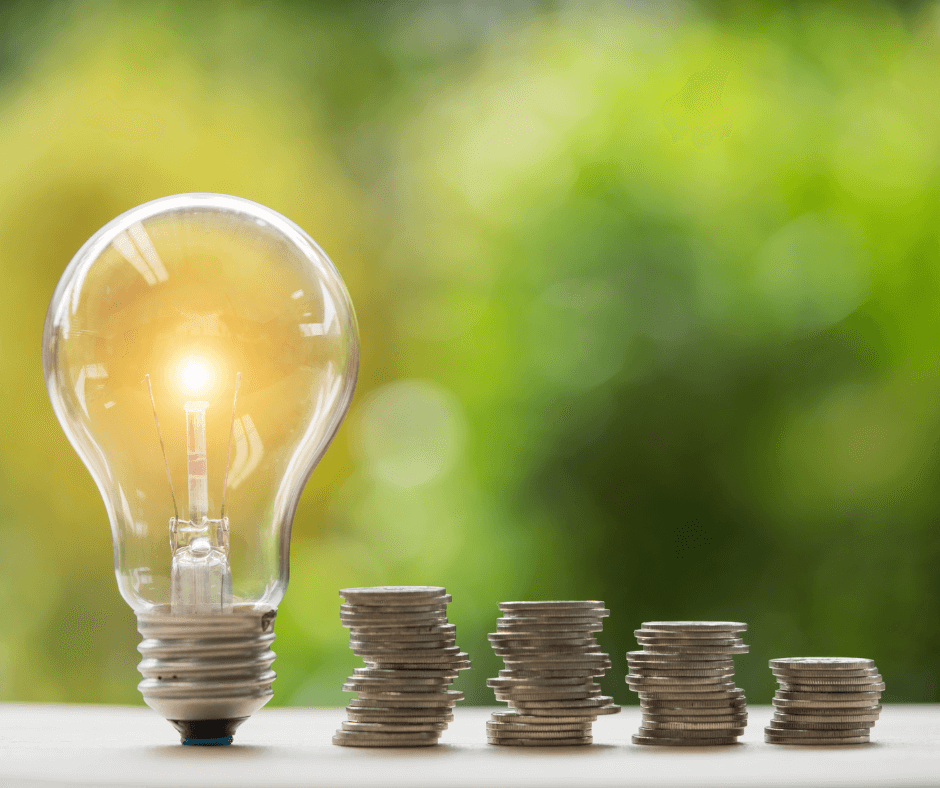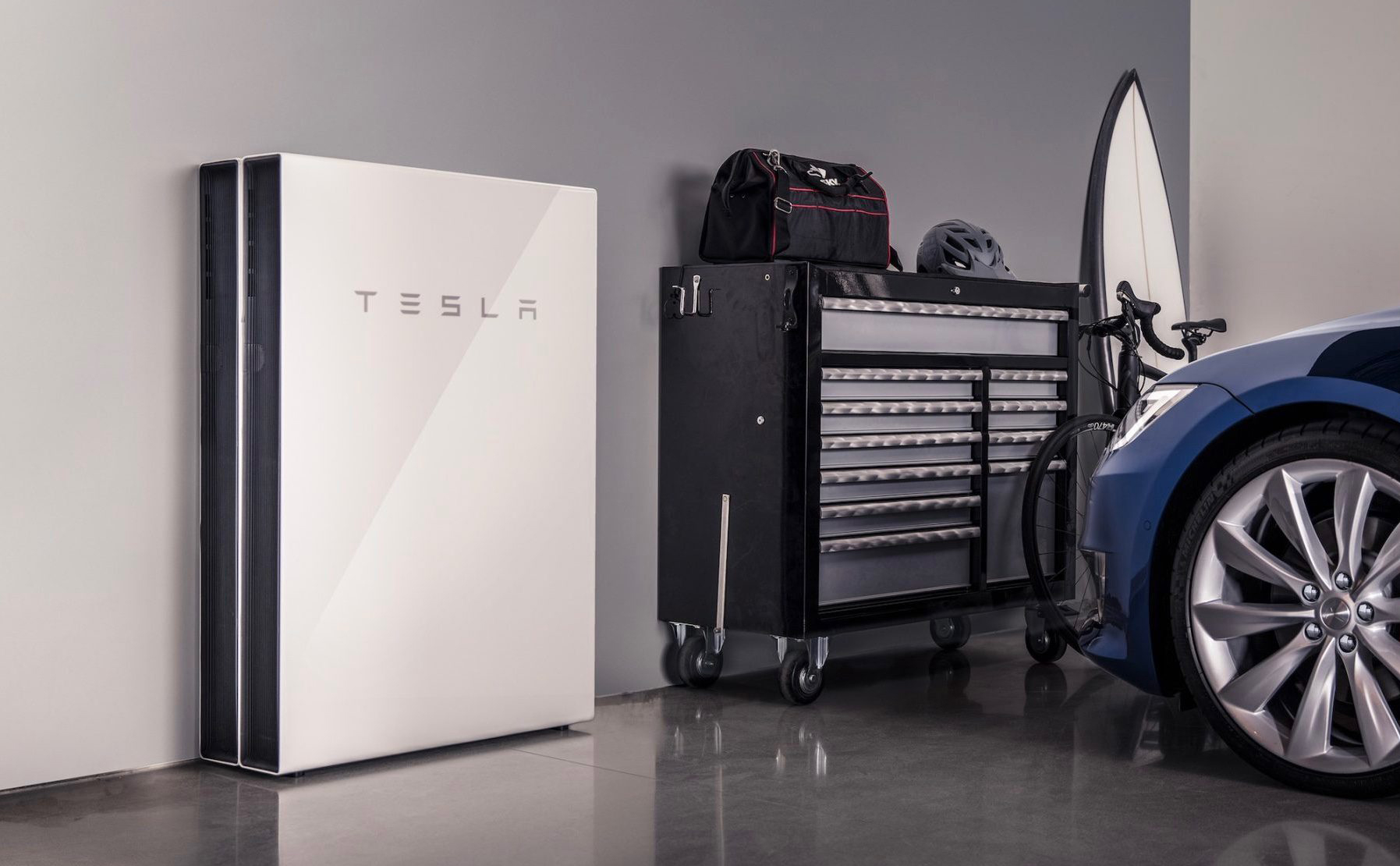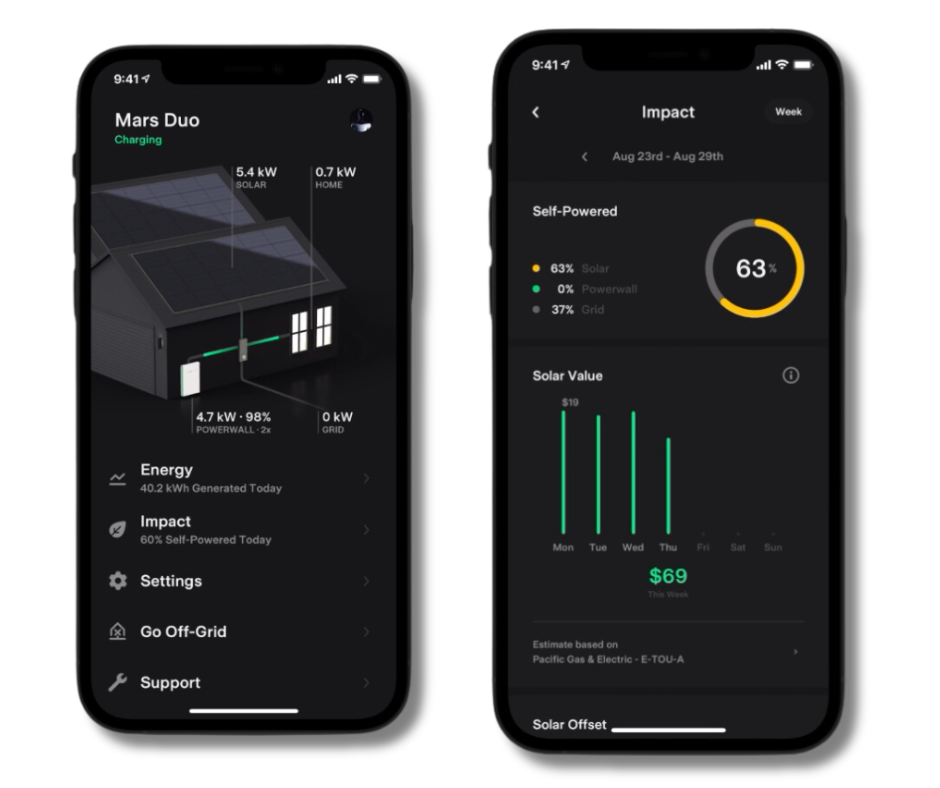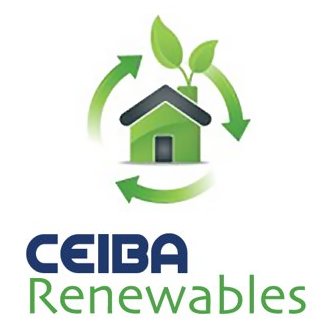by Duncan Crosthwaite | Jan 20, 2025
Lots of customers are opting to install solar photovoltaic (PV) systems to their homes to lower their long-term energy bills and become more environmentally self-sustaining. With many options available to customers, it can be tricky to navigate the options out there and decide what’s right for you.
In this article we’ll explore the importance of battery storage, and why it’s key to unlocking bigger savings and maximising the renewable energy available to you.
The difference between Solar PV and battery storage
If you install Solar PV into your home, without battery storage, you’ll only be able to use the energy you generate immediately, because – put simply – there’s nowhere for you to store the energy you generate.
If you install a battery storage system alongside your Solar PV, you’ll be able to store the energy you generate and use it at a time that suits you. This is especially important for the Scottish climate, where we have long nights for half of the year, and don’t always have an abundance of sunshine.
The benefits of combining battery storage and Solar PV systems
By choosing to integrate battery storage with your Solar PV, you will unlock a number of additional benefits – both financial and environmental:
- Energy independence: By storing the excess solar-generated electricity in battery storage systems, you can reduce your reliance on the grid, providing you with a greater degree of energy independence and resilience in the face of power outages or disruptions.
- Maximise your use of solar energy: Battery storage enables you to obtain the full value of your solar-generated electricity by storing and utilising solar energy during times of low sunlight or peak energy demand. This reduces the amount of grid electricity consumed and lowers your energy bills.
- Reduce your carbon footprint: The combined use of Solar PV systems and battery storage results in lower greenhouse gas emissions and a reduced carbon footprint, making a positive contribution to climate change mitigation and a greener environment.
- Lower energy bills: Storing solar-generated electricity in battery storage systems allows you to utilise clean energy efficiently, reducing your need to purchase and consume grid electricity. This results in lower energy bills, creating substantial, long-term savings.
- Feed-in tariffs and the Smart Export Guarantee (SEG): If you generate more solar electricity than you can consume or store, you can actually sell the excess electricity back to the grid. In the UK, this can be done through the Smart Export Guarantee (SEG) scheme, which provides financial reward for the excess solar energy exported.
- Investment payback period: Although the initial investment in a combined solar PV and battery storage system can seem substantial, the cost savings can offset the investment over time. In many cases, homeowners and businesses can recover their investment in just a few years.
Choosing the right battery storage system
With so many different types of battery and complex terminology to deal with – finding the right system for you, can seem daunting. Pay attention to these three key factors and seek advice from experts – like the team at Ceiba renewables – to choose the right one for you. If you want to know more about selecting a battery system, you can read our blog on the topic – written by our inhouse battery storage experts.
- Battery type: The two main types of battery storage solutions are lithium-ion and lead-acid batteries. Lithium-ion batteries offer a longer lifespan, better performance and efficiency, and are lighter weight, making them the preferred choice for most solar PV system applications.
- Battery capacity: The capacity of your battery storage system should align with your energy consumption patterns, solar PV system size, and the amount of excess solar energy you expect to generate.
- System compatibility: It’s essential to ensure that your chosen battery storage system is compatible with your solar PV system’s components. You can find this out by consulting with an expert in renewable energy, like Ceiba Renewables, to ensure a seamless and efficient integration.
At Ceiba Renewables we truly care about promoting renewable energy solutions that deliver significant savings on energy expenses, empowering homeowners and businesses to transition to a cleaner, more efficient energy future. If you’re in the market for Solar PV, for your home, partner with Ceiba Renewables for expert guidance, design, consultancy, project management, and installation of your integrated battery storage and solar PV system. We’ll provide you with the expertise and the confidence to invest in a sustainable and game-changing energy solution. Get in touch with our team to have a conversation.
by Duncan Crosthwaite | Jan 20, 2025
Energy storage is a hot topic these days, especially in Scotland where the push for renewable energy is stronger than ever. But let’s face it, the world of energy storage can be a bit intimidating. There’s a lot to consider: What kind of storage system do you need? What’s the best choice for your home or business?
Whether you’re a homeowner looking to reduce your carbon footprint or a business owner aiming to make your operations more sustainable, this guide will provide the insights you need to make an informed decision.
What is a battery storage system, in a renewable energy setting?
To put it simply, a battery storage system is a device that allows renewable technologies (like Solar PV or wind turbines, to name but a few) to store the energy they create, so that it can be used at a time that’s most useful.
Without a battery storage system, the energy that’s generated would have to be used right away, whether it was needed or not.
Customers who are looking to integrate battery storage into their Solar PV system, will find they unlock a number of benefits, like uninterrupted power supply, increased independence from the grid, and lower energy bills. You can find out more about the benefits of battery storage and Solar PV in our dedicated blog.
How to Choose the Best Battery Storage System
There are several types of battery storage systems available, and choosing the right one for your needs can be a complex task. The most popular battery storage technologies include:
- Lithium-ion batteries: Currently the most common and widely used battery storage technology, lithium-ion batteries boast a high energy density, long cycle life, and operate very efficiently. They are well-suited to residential and commercial installations due to their compact size, lightweight structure, and low maintenance requirements.
- Lead acid batteries: A tried-and-tested technology, lead-acid batteries provide cost-effective energy storage solutions. However, they have a lower energy density, shorter cycle life, and require regular maintenance compared to lithium-ion batteries – which makes them a less popular choice with consumers.
- Flow batteries: Flow batteries employ a unique, liquid-based energy storage method, that makes them a scalable and long-lasting energy storage option. Although typically associated with larger installations, flow batteries are increasingly being explored for residential uses.
When choosing a battery storage technology, consider factors such as space, maintenance requirements, efficiency, and budget to ensure an ideal fit for your home or business in Scotland.
Understanding the lingo
When choosing the right battery storage solution for you, you might hear a number of terms mentioned. The ones to pay attention to, are listed below:
- Capacity: The capacity, measured in kilowatt-hours (kWh), signifies the amount of energy that can be stored in the battery. You need to make sure that your chosen battery storage system has sufficient capacity to cater to your energy needs during times when solar generation is low. The best way to figure this out – is to speak to an expert – like the Ceiba Renewables team.
- Depth of Discharge (DoD): DoD refers to the percentage of the battery’s total capacity that can be discharged before it requires recharging. Higher DoD values allow you to use more of the stored energy, increasing your battery’s effectiveness and extending its lifespan. A rough rule of thumb is, the higher the DoD, the better.
- Round-trip efficiency: Assess the battery’s round-trip efficiency, which indicates the percentage of energy retained during the charge and discharge process. Higher efficiency values result in more stored energy available for use.
As well as assessing a battery’s performance against each of these metrics, you also need to find one that works for your budget. Remember that as well as the cost of the battery system, you’ll also have installation, permit, and warranty costs. When speaking to customers we often calculate the cost per kilowatt-hour (kWh) for each system, which gives customers an idea of the savings available, against the cost for implementing each system. With our help, we’ll find the right one to suit your needs, that’s financially manageable for you too.
Batter storage systems really are the key to making the most of your renewable technology. And if you’re considering Solar PV – battery storage will give you higher cost savings and better energy use. We’re here to help you navigate the complexities of battery storage systems in Scotland, ensuring seamless integration into your renewable energy setup. Get in touch with Ceiba Renewables today to learn more about our battery storage solutions – it all starts with a conversation, one that we’re more than happy to have.
by Filip Rasinski | Jun 7, 2024
The upcoming release of the Tesla Powerwall 3 is expected to significantly impact the UK’s energy landscape. Tesla, a leading provider of home solar panels, is continuing to advance sustainable energy solutions with its latest Powerwall technology. The Powerwall’s efficient solar energy storage, adaptability to different setups, and contribution to energy security have already made a noticeable impact in the United Kingdom.
The upcoming launch of the Powerwall 3 in Scotland and across the UK has sparked a lot of excitement among homeowners, clean energy enthusiasts, and environmental advocates. This new solar energy battery storage system is designed to work seamlessly with solar panels and other renewable energy sources. It’s expected to give households more control over their energy usage while also reducing their carbon footprint. With its improved efficiency and advanced features, the Tesla Powerwall 3 is set to change the way we use renewable energy systems in the UK. Its anticipated release by the end of 2024 is a big step towards a more sustainable future.
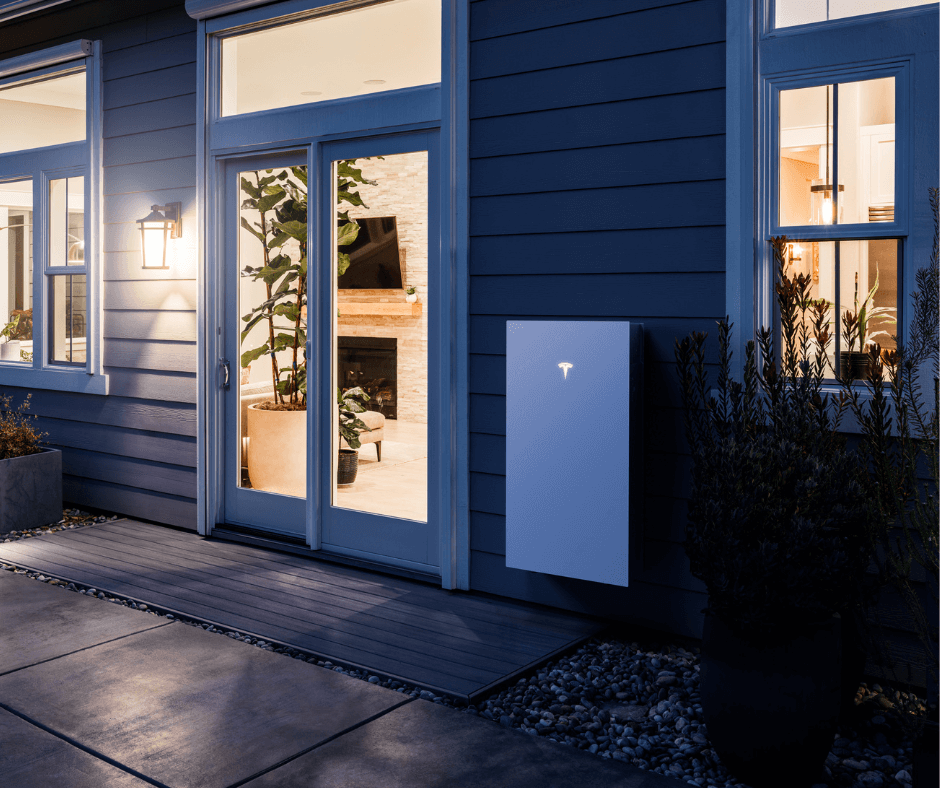
Powerful Key Features and Specifications
Below are some of the key similarities and differences between Powerwall 2 and Powerwall 3.
SIMILARITIES
- Storage Capacity of 13.5kWh of Usable Power per Powerwall
- Scalable (adding a second Powerwall gives you 27kWh of storage capacity)
- Whole House Backup
- Can be Installed Outside (recommended Best Practice from IET & MCS)
- Advanced Battery Cooling for Maximum Durability, Lifespan and Performance
- Tesla’s (mostly) excellent installer and customer Technical Support
Technical details
The Tesla Powerwall 3 boasts impressive features and specifications that set it apart from its previous models. With a nominal grid voltage of 120/240 VAC and a grid type of split phase, it operates at a frequency of 60 Hz. The Powerwall 3 incorporates robust overcurrent protection with a 60A device and offers excellent surge withstand voltage on both AC ports (4 kV) and communication ports (2 kV). It also demonstrates impressive radiated RF immunity at 35 V/m.
One of the standout features of the Powerwall 3 is its exceptional efficiency. It boasts a solar-to-battery-to-grid round-trip efficiency of 89% and a remarkable solar-to-grid efficiency of 97%, ensuring minimal energy losses during operation. The Powerwall 3 supports various islanding devices, including Backup Gateway 2, Backup Switch, and Gateway 3, enhancing its versatility and compatibility.
Connectivity is a strong suit of the Powerwall 3, with Wi-Fi (2.4/5 GHz), dual-port switched Ethernet, and cellular (LTE/4G options available. It also features a hardware interface with a dry contact relay, Rapid Shutdown (RSD) certified switch and 2-pin connector, and RS-485 for meters. The AC metering is revenue-grade, ensuring accurate measurements with a precision of +/- 0.5%.
In terms of safety, the Powerwall 3 incorporates an integrated arc fault circuit interrupter (AFCI), Isolation Monitor Interrupter (IMI), and PV Rapid Shutdown (RSD) using Tesla Mid-Circuit Interrupters, providing comprehensive protection against potential hazards. Customers can conveniently monitor and control the system through the Tesla Mobile App.
The Powerwall 3 offers a 10-year warranty, ensuring long-term reliability and peace of mind for users. With a maximum solar STC input of 20 kW and a withstand voltage of 600V DC, it can handle substantial solar power input. [5] The PV DC input voltage range is 60-550V DC, while the MPPT voltage range is 60-480V DC, accommodating a wide range of solar panel configurations. It features three MPPTs, each capable of handling a maximum current of 13A and a maximum short-circuit current of 15A.
The Powerwall 3 boasts a nominal battery energy of 13.5 kWh, a maximum continuous discharge power of 11.04 kW, and a maximum continuous discharge power off-grid (PV only, -20°C to 25°C) of 11.04 kW. Its maximum continuous charge power is 5 kW, and the output power factor rating is configurable from 0 to 1, allowing for grid code compliance. With a maximum continuous current of 48A and a load start capability of 185A LRA (1s), the Powerwall 3 can handle substantial power demands. Additionally, the system supports power scalability, with up to four Powerwall 3 units supported, enabling users to expand their energy storage capacity as needed.
Please note, some of the above information subject to change once PW3 has been launched in UK.
DIFFERENCES
- The system offers AC- and/or DC-coupled flexibility, making it suitable for new installations and retrofit projects.
Direct DC Coupling
Direct DC Coupling
The Powerwall 3 integrates directly with solar panels, featuring an integrated solar inverter for a more efficient setup and eliminates the need for an additional solar inverter, reducing the required power conversions. In a system with direct DC coupling, the solar energy generated by the panels goes straight into the Powerwall 3’s battery, avoiding the need for additional conversions. This direct charging of the battery results in higher efficiency, with the Powerwall 3 boasting an impressive 96-97% charging efficiency compared to the 92-93% efficiency of the Powerwall 2.
Increased System Efficiency
The direct DC coupling of Powerwall 3 with solar panels contributes to increased overall system efficiency. By eliminating the need for multiple power conversions, the system minimises energy losses, allowing us to harness more of the solar energy generated by our panels.
We can see the efficiency gains when examining the power conversion process in detail. With a DC-coupled system, the solar energy generated by the panels is directly stored in the Powerwall 3’s battery, with charging losses typically less than 3%. In contrast, an AC-coupled system like the Powerwall 2 requires power conversion from DC to AC at the solar inverter and then from AC to DC during battery charging, resulting in a combined loss of around 7%. Additionally, when discharging the stored energy, there is a further 3% loss from converting DC to AC. By minimising these conversion losses, the Powerwall 3’s DC-coupled design achieves a higher round-trip efficiency, allowing us to maximize the utilization of our solar energy.
Moreover, the integrated solar inverter in the Powerwall 3 offers additional benefits. With six Maximum Power Point Tracking (MPPT) inputs, the system can efficiently handle shading requirements across various installations, ensuring optimal solar energy capture. Furthermore, the Powerwall 3’s integrated inverter is programmable, with an output range of 3.68 kW to 11.04 kW, providing greater flexibility in system design and compliance with grid restrictions imposed by District Network Operators (DNOs).
- The system offers AC- and/or DC-coupled flexibility, making it suitable for new installations and retrofit projects.
- It demonstrates improved efficiency in DC-coupled systems, with specific efficiency metrics to be confirmed.
Improved Energy Efficiency
The Powerwall 3 stands out for its impressive round-trip efficiency of 97.5%. This means it can store more solar power before sending it to the grid, which helps minimize energy wastage. Tesla likely achieved this by combining the inverter and battery system, removing the need for an external inverter and improving the overall system design.
- It utilises a distinct cell technology that eliminates the use of rare earth metals.
- The integrated solar inverter delivers various advantages, including improved energy conversion, streamlined data viewing through a single application, and cost efficiency compared to third-party inverters.
Integrated Solar Inverter
The new Powerwall 3 now includes a built-in solar inverter, a significant change from the Powerwall 2, which previously required a separate solar inverter. This new design offers several advantages:
1. More efficient: Connecting solar panels directly to the Powerwall 3’s integrated inverter reduces power conversion losses, making the system more efficient.
2. Easier to monitor: The integrated inverter allows users to monitor and control both the solar and battery systems through a single Tesla Mobile App, making everything easier to manage.
3. Saves money: Eliminating the need for a separate solar inverter saves users money, making the whole solar and storage system more affordable.
In addition, it has 3 individual solar connections, allowing for a maximum solar input of 20 kW or 6.6 kW per connection. This is an improvement from the previous Powerwall Plus model, allowing for more efficient shade mitigation and installing a larger number of solar panels at once. Also, the Powerwall 3’s inverter is programmable, with an output range of 3.68 kW to 11.04 kW. This flexibility allows users to adjust the output to comply with DNO grid restrictions, increasing the chance of getting approval for grid connections that may have been rejected before by SPEN or SSE. This feature promises access to the desired solar and storage system.
- While marginally higher priced than the PW2, when paired with a solar PV system, overall costs are expected to be lower due to inverter-related savings.
- It will offer a non-backup option, reducing costs for customers who do not require backup functionality during power outages.
- Furthermore, advanced features are anticipated within the next 12 months. Detailed information is pending, and updates will be shared once available.
The Tesla Powerwall 3 provides whole-home backup power during grid outages, ensuring uninterrupted power supply to essential appliances and systems. Its Storm Watch feature automatically charges the battery to maximum capacity during stormy weather, offering peace of mind during potential power outages.
The Powerwall 3 enables greater energy independence by allowing storage and use of excess solar energy, reducing reliance on the grid. By combining it with solar panels, you can produce clean energy, reducing carbon footprint and insulating from energy price changes and supply chain disruptions.
Whether you are a business or a homeowner, saving money by storing solar energy during peak hours when electricity rates are higher can lead to significant cost savings and a reduced carbon footprint. Less reliance on the grid will not only maximise the use of solar energy but lead to substantial long-term savings on electricity costs. The integrated solar inverter further contributes to cost savings by eliminating the need for a separate third-party inverter.
Making smart choices about your energy has always been challenging. The Tesla app gives you more control over your total energy usage and generation. It helps you adjust your energy needs and performance, giving you the power of real-life involvement in managing. It feels good knowing that investing in sustainable energy solutions benefits you and the environment.
Expected Launch and Availability
As a leading Tesla Powerwall Installer, we can’t hold our excitement for the upcoming Powerwall 3 in the UK market. Tesla opened orders for the Powerwall 3 in the US in March 2024, and we’re excited to announce that it will soon be available in the UK, which is expected by the end of 2024. As a trusted partner, we’ll be among the first to offer this cutting-edge technology to our customers well before it hits the mainstream market.
It’s important to note that the Powerwall 3 will not be compatible with existing Powerwall 2 setups. This means that for customers interested in upgrading to the Powerwall 3, a completely new system will need to be installed, as the two generations cannot be combined or integrated.
Act now and join our exclusive waiting list to become part of the future of energy solutions!
Get ahead of the curve as Tesla Energy UK gears up for a major announcement this summer. As confirmed by an Ofgem employee in a recent conversation, we expect an exceptional surge in orders as Tesla revolutionises the energy industry. Powerwall 2 units are currently in stock, and we are eagerly anticipating the arrival of the Powerwall 3.
Blog Posts/Articles:
Official Documents/Manuals:
Support/Information Pages:
Other sources:
by Duncan Crosthwaite | Sep 25, 2023
As the world collectively strives towards achieving net zero carbon emission targets, the adoption of clean, renewable energy sources has become increasingly important. Among these sources, Solar PV systems stand out as a remarkably effective solution for reducing carbon emissions and progressing towards a sustainable, low-carbon future.
By harnessing the power of the sun, Solar PV installations provide clean, reliable energy for both domestic and commercial consumers, significantly reducing their environmental footprint. At Ceiba Renewables, we take pride in guiding our customers in their transition to green energy, offering design, consultancy, project management, and installation services that cater to their unique renewable energy needs.
In this article, we will explore how Solar PV systems contribute to global net zero emission goals and examine the essential role domestic and commercial users play in achieving these targets. We will discuss the environmental benefits of Solar PV installations, the value of government-backed initiatives in promoting solar technology, and the broader societal implications of embracing renewable energy.
Moreover, our focus will be on the guidance and support provided by expert service providers like Ceiba Renewables, helping customers make well-informed solar energy choices, and leading the way towards a greener, more sustainable world.
Join us as we delve into the transformative potential of Solar PV systems in meeting the challenge of climate change and ensuring a healthier, more prosperous future for all. By embracing and understanding the power of solar technology, we can collectively contribute to the global mission of attaining net zero emissions and preserving our planet for future generations.
The Role of Solar PV Systems in Meeting Net Zero Carbon Emission Targets
1. The Environmental Benefits of Solar PV Systems
Solar PV systems provide a range of environmental advantages that contribute to the global ambition of reducing carbon emissions and addressing climate change:
- Clean and Renewable Energy: Solar energy is abundant and limitless, providing a reliable and sustainable power source for both domestic and commercial users without producing harmful greenhouse gases.
- Reduction in Fossil Fuel Consumption: By adopting Solar PV systems as an alternative energy source, the reliance on fossil fuels—all of which contribute significantly to carbon emissions and pollution—is mitigated.
- Decentralised Energy Generation: Solar PV installations support the transition towards a decentralised energy model, reducing the need for polluting, centralised power plants and promoting clean, locally generated energy.
2. Government-backed Initiatives to Encourage Solar PV Adoption
Government policies and incentives play a critical role in promoting Solar PV technology and fostering green energy investments:
- Green Energy Subsidies: Governments worldwide offer various subsidies and grants to reduce the upfront cost of Solar PV installations, making renewable energy more accessible and attractive to businesses and homeowners.
- Feed-in Tariffs and Smart Export Guarantee: Although the UK’s Feed-in Tariff scheme closed to new applicants in 2019, those with Solar PV systems installed before this date continue to receive payments. Meanwhile, the Smart Export Guarantee provides payments for surplus solar energy exported to the grid from new installations.
- Energy Efficiency Regulations: Governments globally have been tightening energy efficiency regulations and incorporating mandatory renewable energy targets for new buildings, spurring Solar PV adoption and contributing to meeting net zero emission goals.
3. The Role of Domestic and Commercial Users in Reducing Carbon Footprint through Solar PV Adoption
Both domestic and commercial customers play a vital role in advancing net zero carbon emission targets by embracing Solar PV technology:
- Awareness and Commitment: Increasing public awareness of the environmental benefits of solar energy helps build a sense of responsibility and commitment to adopting renewable energy solutions as part of everyday life.
- Financial Incentives and Benefits: As we have previously discussed, domestic and commercial users can enjoy financial benefits through cost reductions, income generation, and government incentives, encouraging their transition to Solar PV systems.
- Promoting Corporate Social Responsibility (CSR): Businesses that invest in Solar PV installations demonstrate a commitment to environmentally sustainable practices, enhancing their brand image, and inspiring others to invest in renewable energy-based solutions.
4. Supporting the Solar Energy Transition: Expert Providers like Ceiba Renewables
Working with expert service providers like Ceiba Renewables is vital in facilitating a smooth transition to Solar PV systems:
- Tailored Solutions: Ceiba Renewables offers customised design, consultancy, project management, and installation services, ensuring the seamless integration of Solar PV systems according to unique customer requirements.
- Education and Guidance: We provide valuable information on Solar PV technology, helping customers make informed decisions and maximising the environmental impact of their investments.
- Continuous Support and Maintenance: Solar PV systems require professional care and maintenance to ensure efficient performance and maximise their lifespan. Ceiba Renewables offers support and maintenance services to ensure customers enjoy the full benefits of their Solar PV system.
The Collective Mission of Achieving Net Zero Emissions through Solar PV Systems
The adoption of Solar PV systems is pivotal in the global drive towards achieving net zero carbon emissions and confronting the challenges of climate change. By understanding the environmental benefits of solar energy, we can collectively take strides towards a cleaner, more sustainable future.
Both domestic and commercial users play a vital role in the pursuit of net zero emissions by embracing Solar PV technology and the benefits it brings. Meanwhile, expert service providers like Ceiba Renewables are instrumental in delivering tailor-made solutions and providing guidance for customers to make well-informed decisions.
Together, we can embark on a journey towards a greener and healthier world by investing in Solar PV systems, driving innovation, and ensuring that we meet the targets set for a net zero emission future. With Ceiba Renewables by your side, you can contribute to this collective mission confidently, knowing you have a trusted partner backing your transition to clean, renewable energy, and helping shape a brighter future for all.
Ready to start saving on your energy bills and earning income from your property? Look no further than Ceiba Renewables, a solar PV company! Our team of experts provides design, consultancy, project management, and installation services for both domestic and commercial customers. We specialise in helping customers reduce their energy overheads and maximise their energy efficiency by utilising the latest in solar technology. Contact us today to learn more about how we can help you save money, reduce your carbon footprint, and take control of your energy needs!
by Duncan Crosthwaite | Aug 28, 2023
Investing in a Solar PV system is an effective method for reducing energy costs and harnessing the power of renewable energy. However, ensuring optimal efficiency and performance from your solar installation is crucial in attaining the maximum benefit from your investment. As specialists in the design, consultancy, project management, and installation of Solar PV and battery storage systems, Ceiba Renewables prioritises helping customers harness the full potential of their solar installations.
In this article, we aim to provide expert tips and guidance for enhancing the efficiency of your Solar PV system. We will cover essential aspects such as system maintenance, positioning and angle of solar panels, monitoring and adjusting energy consumption patterns, and utilising technological advancements to maximise performance. Additionally, we will underline the importance of working with professional service providers like Ceiba Renewables to ensure seamless integration, expert support, and the best possible results for your solar energy venture.
Join us as we share valuable insights for maximising the performance of Solar PV installations and delve into the intricacies of obtaining optimal efficiency. By applying these expert tips, you will be better equipped to maximise your solar energy investment, ultimately reaping the full rewards of renewable energy solutions. With the right knowledge and support from Ceiba Renewables, maximising Solar PV efficiency becomes achievable, paving the way for substantial energy savings and long-term sustainability.
1. Optimising Solar Panel Positioning and Angle
The positioning and angle of your solar panels play a vital role in their performance and energy output:
- Orientation: In the UK, solar panels should typically face south for maximum sun exposure and energy generation. However, shade and roof layout may require adjustments to this rule.
- Angle: The angle at which solar panels are installed significantly impacts their efficiency. Working with Ceiba Renewables, we can help you determine the optimal angle for your panels based on your location and property characteristics.
- Avoidance of Shading: Shade on solar panels can severely affect their performance. Ensure your panels are strategically placed to minimise shading from nearby trees and structures.
2. Monitoring and Adjusting Energy Consumption Patterns
For maximum energy savings, it is essential to monitor and adjust energy consumption patterns in line with your Solar PV system’s output:
- Energy Monitoring: Utilise energy monitoring tools and smart metering systems to track energy production and consumption, allowing you to make informed decisions about when and how to use energy most efficiently.
- Time-of-Use Adjustments: For best results, align high energy consumption activities, such as laundry or cooking, with peak solar production periods (usually during the daytime).
- Energy-Efficient Appliances: Invest in energy-efficient appliances, lighting, and HVAC systems to reduce overall energy consumption and achieve the best results from your Solar PV system.
3. Regular Monitoring and Proper Maintenance of your Solar PV system
Ensuring optimal performance from your Solar PV installation includes regular monitoring and proper maintenance
- Production Monitoring: Regularly monitoring your system production through the monitoring apps will allow you to know when your system needs maintenance and identify any issue immediately.
- Component Check-ups: Quarterly inspections of the installed components, such as connections, cables, and mounting hardware, can help identify and address any potential issues promptly, ensuring continuous, optimum performance of your Solar PV system.
- Professional Support: Partner with expert service providers like Ceiba Renewables for consistent and thorough system maintenance. Our team of professionals can ensure your installation runs at peak efficiency and pre-empt any potential issues.
4. Embracing Technological Advancements and Smart Solutions
Maximising Solar PV efficiency involves staying up-to-date with new technologies, software, and tools designed to improve system performance:
- Solar Performance Software: Use solar performance monitoring software to track energy generation, system performance, and potential issues, ensuring continual optimisation.
- Solar Optimisers and Micro-Inverters: Explore technologies like solar optimisers and micro-inverters, which can increase the efficiency of individual solar panels and maximise power output.
- Battery Storage Integration: Consider integrating battery storage solutions with your Solar PV system, allowing for the storage of excess energy generated during daylight hours, which can be utilised during periods of low solar production or increased energy demand.
Maximise Efficiency and Reap the Rewards of Your Solar PV System
Harnessing the full potential of a Solar PV system involves taking proactive steps to ensure that efficiency, performance, and energy savings are maximised. You can make the most of your solar energy investment by applying expert tips, such as proper maintenance, optimising panel positioning, monitoring energy consumption patterns, and embracing technological advancements.
Partnering with professional solar energy specialists like Ceiba Renewables ensures you receive sound guidance, expertise, and ongoing support in your Solar PV journey. Our team is dedicated to helping you optimise the performance of your Solar PV system, delivering long-term energy savings and contributing towards a cleaner, greener future.
With Ceiba Renewables by your side, maximising Solar PV efficiency is achievable, leaving you to enjoy the benefits of energy savings, reduced carbon emissions, and significant advancements in renewable energy technology. By taking these expert tips to heart, you can unlock the true potential of your Solar PV system, paving the way for a brighter, more sustainable future.
by Filip Rasinski | May 27, 2022
We are very grateful to have been awarded as the “Solar PV Installer of the Year” at the Scotland Energy Efficiency Award 2022 for the second time.
This year it is even more exciting as we were able to share the recognitions with our roofing partner, Eco Solutions with the “Highly Commended Small Project of the Year”. The team have done an excellent job at our customer’s home in Perthshire and we were very lucky to have our customer and his wife celebrating with us as well that night.
It is a special moment as we believe that more appreciations to small project like this could be the inspiration and encouragement for other property owners to move into renewable energy and take the opportunity to be self sufficient. It also strengthen our confidence in providing the best solutions for our customers.
We are deeply honoured to be acknowledge with high standard customer service and top quality workmanship and considered to have demonstrated best practice within the local community. The industry is continuously growing and it is even more crucial for us to focus on quality and longevity to provide only the best for our customers.
*Learn more about the project on our case study page: https://www.ceiba-renewables.co.uk/project/residential-in-roof-project/
